|
SPEX
Year: 1969
Country of Origin: USA
Host: GT4 & GT5
Class:
Sports Car
Type: 2-door coupe
Price: $71,500 (GT4 Stingray 350)
$51,353(GT5 Stingray L46)
GT5 Mileage: 4,241.2
Construction: fiberglass body, steel frame
Length:
182.5" // Width: 69.0" // Length: 47.8"
Wheelbase: 98.0"
Overhang: 7 feet 5 inches
Track: 58.7 [F] 59.4" [R]
Ground
Clearance: 5.3"
Weight: 3,284 pounds
Wgt Dist: 48.5/52.5
Steering: recirculating ball
Turns lock 2 lock: 3.450
Radius:
40 feet 0 inches
Layout: Front Engine / Rear Drive
Tires: F70 x 15
F. Susp: wishbones, coils, shocks, anti-sway bar
R.
Susp: wishbones, semi-elip. leaf springs, radial arms, shox, anti-sway bar
Brakes: vented discs
*No oil change
or engine rebuild was performed on either car (GT4 or GT5)
Engine: 350 cubic-inch OHV V8
Aspiration:
natural
Fuel System: single 4-barrel carb
Valves / Cyl: 2
Bore x Stroke: 4.00 x 3.48"
Compression: 11.0:1
````````````````````````````GT4``````````````````````````GT5````
Garage BHP: 351 @ 5,600 rpm 347 @ 5,500
Grg. Torque: 360 @ 3,600 rpm 390 @ 3,500
Credits
per HP: $203.70
$147.99
Pounds per HP: 9.36
9.46
Pounds per Tq: 9.12
8.42
Hp per Liter: 61.5
60.5
GT4 Idle: 550 // Redline: 5,800 // RPM Limit: 7,000
GT5 Idle: 625 // Redline: 5,750 // RPM Limit: 6,000
Transmission:
4-speed manual
Differential:
*all current testing performed on S2 tires in GT4 and Hard Sports in GT5
```````````````````````GT4``````````````````````````````````GT5```````
0-60 mph: 6.250 seconds
5.571 seconds
0-100 mph: 12.733 seconds 12.011
seconds
0-150 mph: nil
nil
400 M: 14.754 @ 107 mph
13.968 @ 108 mph
1 Kilom: 25.490 @ 138 mph 25.238
@ 123 mph
1/4 Mile no test 14.017 @
109 mph
1 Mile no test
36.321@ 123 mph
Test Course Lap: no test
100-zero mph: 3.96 seconds
5.350 seconds
Top Gear RPM @ 60 mph: 2,800 (GT4) 2,750 (GT5)
Top Speed at Redline (GT4)
1st: 56 mph
2nd:
74 mph
3rd: 97 mph
4th: 138.39 mph @ 6,500 (gearing limited)
Top Speed at Redline: (GT5)
1st:
55 mph
2nd: 75 mph
3rd: 95 mph
4th: 124.xx mph @ 6,000 (gearing/tach limited)
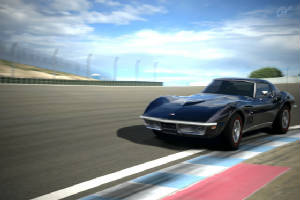
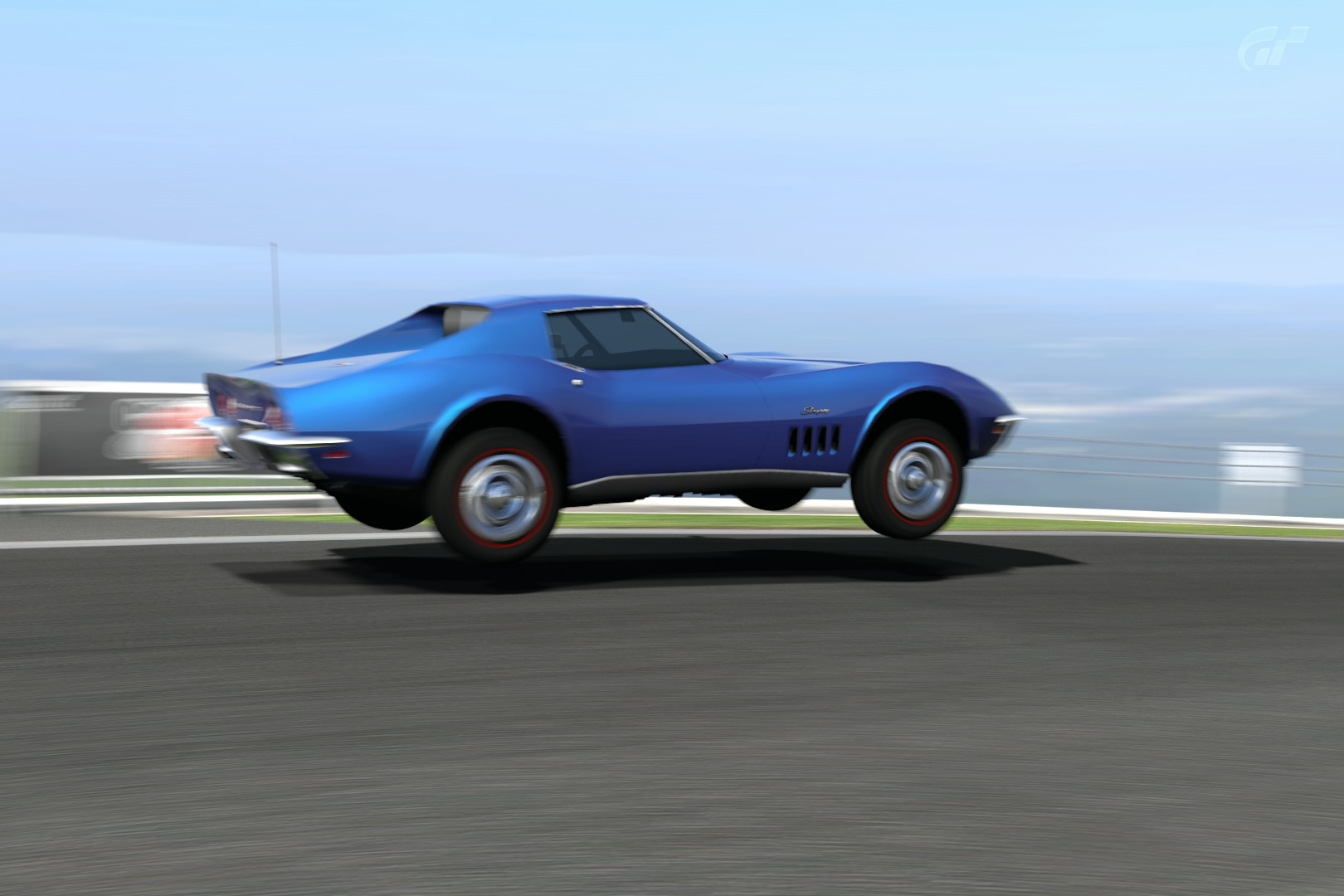
---------EXTERIOR / HISTORY-----------
Yep, that's right, here's yet another Corvette review, this time it's being written about the 'Vette's C3
generation. Will there eventually be a GT Car Review for all Corvettes of Gran Turismo? It's looking to
be that way. Wish I could get half as fanatical about Skylines.
There are actually several C3-generation
cars in Gran Turismo. There's one which first appeared in GT2, although I somehow never tested, raced,
or drove it. This would have been the Stingray 427.
The Stingrays of GT4 and 5, on the other
hand, feature a small-block 350 c.i.d. engine. I'm actually glad we don't get a big block (427) in these games.
In a perfect world, we gamers would have both versions (350 and 427), but if I had to choose one over the other,
I'd prefer the small block, simply because GT focuses so heavily on circuit racing. Even with this smaller engine, the '69
Corvette Stingray is very problematical.
Well, this Corvette has some history, so here goes.
Started out
as the Mako Shark II, a concept developed during the mid 1960s. It is said that Bill Mitchell, cheif designer at the
time, caught a mako shark while he was fishing, and hence came inspiration for the name of this concept. But for
whatever reason, the name 'Mako Shark' didn't stick around. Early on, the Mako Shark II was going to have a mid-engine/rear-drive
layout, just like some Italian sports coupes of the time, but I think Ralph Nader's book: Unsafe at Any Speed, caused
Chevy to change their mind. This book was mostly about the Corvair, a rear-engine coupe which had really undesireable handling
traits. Front-engine/rear-drive layouts had been proven, so that was that.
The Mako's brand-new body design
was highly unique. Though the Mako Shark II never made it to production, the C3 generation of Corvette Stingrays took
styling cues heavily from the Shark. America was at its peak so far as style goes during this time, with
the Stingray leading the way.
Nothing on the automotive market had ever been seen like it before, from
America or Europe. Its curvy, swoopy fiberglass body was inspired in part by Jaguar's E-Type, yet the Corvette managed to
not look as though it was aping Europe. It had an American look for sure. The new Corvette looked slipstreamy,
but was actually not very aerodynamic. But who cared? It looked way cool, and it would guarantee sales!
But
still, the C3's drag coefficient rated somewhere above 0.50, which is pretty high for a sports car. The
newest C6 generation, for instance, boasts a super-slippery drag of 0.28. Not that this matters much; the
older C3 is still a fast sports car most of the time, aerodynamic or not.
Chevy was very secretive about the newest
version of the Corvette before its debut. The Mako Shark II was never shown at a car show, for instance, until after the Stingray
hit the market. But it's been said (at Wikipedia and other sites) that just before the C3's release in 1968, Mattel
came out with their Hot Wheels line of toy cars, and one of the models was the 'Custom Corvette', which was based either on
the Mako Shark II or the actual new Corvette Stingray C3! So Chevy's cover was blown, basically. But no lawsuits were
filed, apparently, like they would have been today.
At 3,284 pounds, the Stingray 350
is rather heavy for its era (considering it was a 2-door sports car, not a lunky 2-door hardtop), but perfectly average in
the world of Gran Turismo. It's interesting that the real-life car with a small-block 350 has a slightly rearward (48.5/52.5
front/rear) weight bias. During many races, the Corvette's rear tires warm a bit faster, even if there's no burnouts or
anything like that. Did PD know about this rear-weight bias? Possibly so.
Three weight reductions,
and presto....there goes 494 pounds, for a minimal weight of 2,790 in GT4. Almost Shelby
Series 1 country...nice. At $71,500, the GT4 Stingray costs roughly $63,000 more than a C3
would have sold for in 1969! Even as a used car in GT5, the dealerships are asking just over $50,000.
So
is it worth these inflated prices? Or is the 'Vette worth its original price?
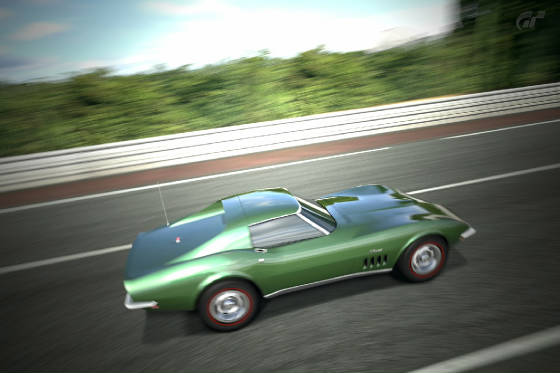
-------------------ENGINE / DRIVERAIN------------------
Wow. Since there's an American V8, I expected it would be yet another beast of a motor, but boy was I wrong.
What a wimp!
...Naw, just kidding. ;0 As usual, the engine is the best part of the car (besides the fact that
it is as cool-looking as Johnny Depp is twisted). The Corvette Stingray 350 doesn't disappoint in the engine department;
it puts on quite a show at all times.
Rumbling around tighter areas like at a slow-fast track such as Laguna
Seca, and then ROARING down the straight. It never gets old. Always feels fresh and fun. One early criticism is
that PD used the same exact sample for the engine/exhaust's sound as they did for the C4 and C5 Corvettes, thinking perhaps
we'd never notice. But it all sounds good. GT5's 'Vettes do not suffer from this problem, however. PD got distinctly
different set of soundbytes for this game.
In 1969, Chevrolet stopped using the 327 small-block,
and upgraded to the 350 that's in our game-car. The big block went from a 427 to a anchor-like 454!
...Geez.
I was born in the wrong era. I mean, modern times are interesting. Nowadays, we have huge advances in computer wizardry
from year to year, creating cars that are more and more clever and track-ready, even if they're also okay to drive on regular
roads. That's all good, but it must have been really exciting to live during a time when all that mattered was horsepower.
And just plain looking cool ... looking as bad-ass as possible. ;-/
Anyways, nothing new here. Lots
of power, lots of torque. Bla bla bla. Anybody out there wanna finish the rest of this predictable review? :lol:
Peak
torque and power can be grasped from typical spots: 3,600 and 5,600 in GT4 (GT5 rates 100 rpm lower for both figures). Below
4,000 rpms, the engine also suffers from typical small block hesitation in GT4 (even in 1st gear, sometimes) before
rocketing off. But in GT5 this is no longer true. Notice the Zero to 60 mph time in 5 is many tenths of a second lower than
GT4's... 5.883 as opposed to 6.250.
The redline is too low, which means we'll need to push that tach needle past
redline frequently, but I rarely had problems hitting the V8's RPM limit.
This year of Corvette (1969) was one
of the last to follow Chevy's famous mid-century tradition of "one horsepower per one cubic inch", which started back
in 1957. It was something of a milestone when Chevy first accomplised it, and 12 years later was still a great attribute,
not to mention one hell of an advertizing slogan. For this reason, the 350 c.i.d. engine is quoted at 350 hp by
the Chevrolet dealer in GT4. GT5 cars (some of which are used) typically rate lower than this, but an oil change will easily
bring us close or exactly to 350.
Chevy also boasts 380 foot-pounds from 3,600. At the garage,
our dyno apparently doesn't fully agree since torque rates 20 hp less than the dealer quotes at
360! GT5 puts the L46 I'm testing at 370 after oil change.
There
are three NA kits, plus (guess) a supercharger to be had in either GT4 or GT5. All the little stuff (mufflers, balancing,
'computer', etc, don't add as much power as they do sometimes with more modern cars. There is no 30 horsepower jump when going
from a stock muffler to a full-racing pipe, for instance. But otherwise, power upgrades are acceptably grand. It's dramatic
to put them all on paper. Well, virtual paper. GT4 has
Stage 1: 437
@ 5,600 rpm / 401 foot-pounds @ 3,600
Stage 2: 495 hp / 440 foot-pounds
Stage 3: 593 hp / 569
foot-pounds
Supercharger: 565 hp / 622 foot-pounds
*****************************************************
And
in GT5 we can arrange
Stage 1: 484 hp @ 5,900 / 482 foot-pounds @ 4,200
Stage 2: 531
hp @ 5,900 / 520 ft-lbs. @ 4,300
Stage 3: 569 hp @ 6,000 / 548 ft-lbs. @ 4,400
Stage 3 + supercharger:
647 @ 5,900 / 679 @ 4,400
*****************************************************
Check out the
jump from Stage 1 to Stage 2, and then Stage 2 to Stage 3 in either GT4 or 5! Yowza. Satisfying, but also dangerous.
There are lots and lots of reasons why some gamers should simply never experiment with top power, and plenty of reasons why
other gamers (who can handle it) should mess with it.
Finally, let's finish off this section with a multiple
choice quiz. Ready?
The C3 generation was offered with both automatic and manual transmissions. Our game car gets
the 4-speed manual, thankfully, not a 3-speed automatic. This manual transmission is...
1). Geared too short.
2).
Geared too short.
3). All of the above.
Still, the stock 4-speed can be safely used at a long
list of tracks (assuming power is still lowish): Laguna Seca, Infineon Raceway, Cote d' Azur, Tsukuba, the list goes
on and on...
It's okay to just skip the next section if you've already driven this car. But I gotta write
it anyways.
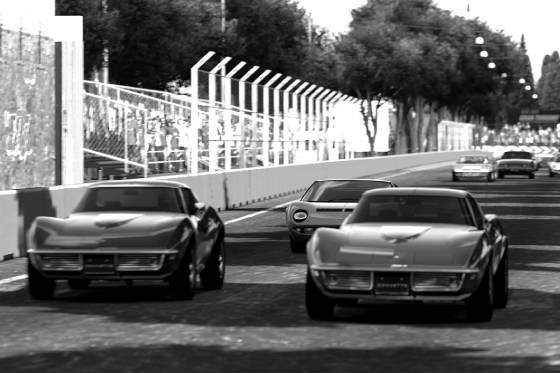
-----------CHASSIS / HANDLING------------
I sometimes try to imagine what it must have been like when the master designers of the day were trying
to put the C3 on the American/Canadian market. Working long hours in large stark rooms with fluorescent lighting. Using large
sheets of paper (instead of a computer screen) with slide rules, drafting tables, and mechanical pencils always at hand. Chain-smoking
indoors because nobody knew cigarettes were bad yet, or how bad.
...Did they also know how dangerous
the latest edition of the Corvette would be? Is it something they considered, or something nobody considered?! Were
they all just so obsessive and excited about how much POWER the newest Corvettes would have, without really putting time to
study what to do with this power?
GT4
And
the funny thing is, the '69 Chevy Corvette Stingray is one of the BEST-LOOKING cars, whether it's sitting still or in movement
It's one of the most photogenic too, even as it's losing its balance, getting slightly sideways...even as
it's braking too late into a corner and tossing some sand! It always looks good. Before we actually drive it, it
looks like a car that's ready to shred some pavement with confidence, does it not?
In a way, the C3 (as it
snaps and skews its way thru many a corner) actually drives like an aquatic sting ray swims. Sting rays tend to swim
along gracefully, yet when they're angry, they also snap and lose their cool. Sort of like the way this car loses its composure.
So back
to the car-Stingray. The reality is not good. Those chain-smoking engineers may have been proud to offer the Corvette's
J56 heavy duty brakes, revised suspension, but the reality is none of this would make much difference in the long run. The
C3 is (my opinion) the WORST Corvette of Gran Turismo 4!
The '54 Corvette C1, for instance, rates unrealistically
high because PD screwed up its braking and overall handling traits, which means it maneuvers and brakes way better than it
should. The '63 Corvette Stingray is problematic, not as competent as the C1 (as portrayed in the game), but
it's also possible to tune and work with the C2's worst behaviors.
But like I was saying, the C3 is definately
the loser of the pack, even with its totally independent suspension. Disc brakes at all four corners rate
decently during a straight-line braking test; they do the best they can at various Gran Tusismo tracks, but the
car's tires simply can't handle anything too extreme. Really, that's a huge part of the problem...the 70x15 tires. And the
fact that the suspension is set so softly.
With N3 tires on, we've got genuine Polyglas redlines! Dead-sexy,
even on a car with a "Fathom Green Metallic" drabby paint job! These tires don't do very well in the big,
wide world of racing, unfortunately. The C1 feels like a modern GT at times. The C2 is problematic when driven at speed,
but when driven mildly feels somewhat balanced and neutral.
Well, the '69 C3 simply feels
like a muscle car, sport tires or N tires. Simple as that. It drives just as badly as most
others living nearby at Classic American dealerships. Brake-in strong. You might think you've used enough force, and
in many other cars, such braking force (and entry-time) would be sufficient or more than sufficient. Yet
the C3 still pushes, still barely keeps itself from roaming happily off-track, even as the driver feels the
car is rolling too slowly. It gets to be frustrating at times.
LOTS of brake time must be devoted. As the car nears the
next corner, it WILL start to understeer if there is a dab too much speed. But if it's entering at the proper
speed, the car finally grips-in. Now, lay on the gas-pedal, and weeeessssssssssss goes the inside-rear wheel! It
doesn't take much to get this going, either. In real-life, most 'Vettes from this era were equipped with 'Positraction' limited-slip
differentials, according to
http://corvettec3.ca/axle.htm
The C3 in our game is apparently supposed to be one of the Positraction-equipped
models, since it's got a 3.700 rear-axle drive (equipped a full-custom transmission, and looked at its default final drive
setting to come to this conclusion), yet it barely seems to make any difference.
Thankfully, any differential we equip
from the Chevrolet Tune Shop quickly kills 90 to 100% of rear problems.
The car's handling still really blows with
either sports or semi-racing parts, but it is possible to win plenty of races with these lesser parts in place,
provided the driver is patient and uses plenty of brake-time. Braking is really the most important aspect. Braking is about
70% of what's left to address (after a limited-slip is installed, that is).
Full-racing parts? Finally
the Corvette starts feeling classically sports-car like! But it still takes lots of practice, lots of temperance,
to handle the Stingray.
GT5
Things only expand, variables only deepen
during 5. I have several '69 Corvettes in this game, some Standard and some Premium. The test car in the Specs section of
this review is just a baby, its engine just broken in with a little over 5,000 miles on it. Then I started
driving a used L46 model with about 27,800 miles on its odometer. This car was also raced in the Amateur Series
Supercar Nostalgia Cup. That's what the following driving impressions are derived from.
Everything
about the C3: its tendency to feel like a muscle car, for instance, only becomes more pronounced from GT4 to GT5. You don't
so much drive this car into corners as you'll find yourself stuffing it in, like you're trying to cram a letter
into an overstuffed mailbox, especially now that ABS braking can be canned. You don't so much get a "little sideways"
out of turns as in GT4. Now the Vette proudly hurls out of those same turns; and gets as sideways as the driver wants
to get (and sometimes doesn't want to get). It's hella fun, but also hella difficult.
One of the best
things, however, is there is definitely less understeer than there was in GT4, even if soft comfort tires are being used.
Now there is some understeer still left over, don't get me wrong, but there's also a grippyness which was absent
in GT4. The "leftover" understeer mostly shows up on-entry. When exiting, the Corvette is usually now oversteering much more
forcefully; swinging the rear of the car so that the front-end usually is more like the one "in command" at these moments.
But
the bad part. Overall, this used Corvette feels simply flimsier than it did in that past game. Chassis rebuilds are mandatory
on used cars, unless those used cars have very low mileage, but there's still going to be an overall flimsy sort of feeling
no matter what we do.
Braking is also very difficult. In GT4, I complained that lots of braking time is necessary
to avoid understeer on-entry, and this is still true, but now we must also consider the rear can now also get sideways
under braking. This is true with non-ABS cars, mostly. But if lots of brake-time is given early and in a straight
line, the '69 corners a little better than it did in GT4. Like I said, its front-end now offers more grip than it
did in that previous game.
But the thing is, it's rare we'll actually be finding ourselves maintaining this grip for
any length of time! The '69 Corvette in this game is like a wildcat with rabies, roaming thru the neighborhood, terrorizing
all with its meanness!!! ...>>> Constantly sliding, constantly slipping and getting squirrely
out of turns. Constant whip-sawing being caused from throttle AND braking! It's tough to keep this baby under control.
It is possible to keep it under control, but (just as in a muscle car) rarely are we going to be able to push this
one excessively during cornering. Push a little too hard, and there goes a position. Clouds of smoke!
Tuning
becomes mandatory at some point, just as it did in GT4. Limited-slips and better suspension tuning? It's like a small miracle
has happened, as lap times dwindle and cornering speeds rise. The difficulty level, however, stays the same. The C3 Corvette
in this game always feels tricky to drive. There is no "easy" switch we can choose. And yet, I admit I've sometimes
made my best lap times during laps which didn't look as though they'd be my best. It's like the Vipers I drove in GT and GT2:
sometimes those better lap times happen in a car which is constantly losing its composure; tires smoking & shrieking!
I try and get a better time by slowing down a tad, try to go for some classic out-in-out lines, only to see the
ghost car (which is tangoing from side-to-side as it exits turns) getting firmly ahead! Arrrgh!
Legends
can be made and faces can be turned as you race this one about, but it's not always that "polarized" paint job that they'll
be awed by. In most cases, the spectators watch us as we drive the '69 not just because we've got a good-looking automobile,
but also because it's a good-looking automobile which is about to do a face-plant into a wall...going sideways and backwards!
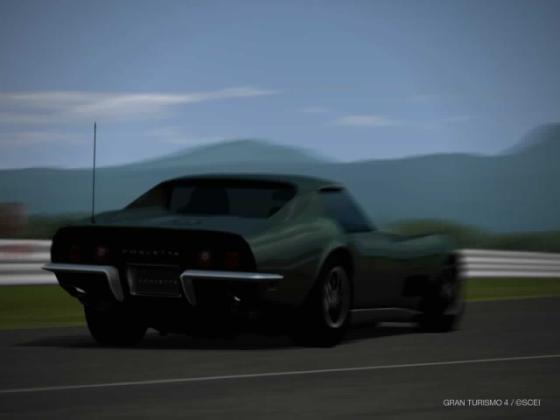
PROS----------------------------------------
1). "One horsepower
per one cubic inch!" says the goofy, plaid-suited salesman. And for once he's not lying.
2). Power only
gets better. Each stage of NA power becomes exponentially stronger than the previous. Supercharger is almost ridiculous with
torqueyness.
3). Polyglas Redline tires (if N tires are installed) in GT4. GT5 has Redlines on at all times.
4).
Swoopy, fiberglass bodywork. Lots of colors we can buy a '69 Stingray with. I'm almost ready to ask this car out on a date.
5).
Back to the engine, and its capability of going from grumbly to ferocious. Tires shred! Aurally, a combination of Mozart and
Megadeth.
6). Weight reductions remove almost 500 pounds at best.
7). Just as photogenic as can be, as it
leans, dips, and rolls about. Gets snappy as its rear tires lose a bit of traction. I Never get tired of watching this
car, I almost feel like a stalker, after awhile...like I start feeling guilty or something.
CONS----------------------------------------
1). Geez, there's so many...where
to start? #1 is the fact that this car looks so track-worthy, yet has (truthfully) just left Gran
Turismo grade school...with plenty of Ds and Fs on its report card.
2). Lots of power, but none
of the handling to match it.
3). Difficult to brake into turns, even in GT4 with its mandatory ABS brakes. GT5 only
gets more and more difficult if the driver choses to switch ABS off. Understeer and mini-slides are always a moment
away.
4). Rear-end loses it all until a limited-slip device is installed. Raise some power, and it starts
slipping again!
5). Pricey.
6). Heavy, and heavy-feeling too. This car always feels so heavy,
man, as they said in the sixties. Slow steering. Slow turn-in. Difficult to orient. Yet the '69 'Vette doesn't
always feel stable despite its pounds.
7). Typical small-block hesitation. Below
3,500 rpms, the 350 feels like it needs some coffee. This is truer in GT4 than it is in GT5.
8). 4-speed transmission,
typically geared too low for over half the tracks we'll be racing on.
9). Some exhaust samples sound generic and un
V8-like. Semi-racing is best example. GT4: Stock Stingray 350 sample sounds exactly like V8s from later Corvette generations,
because PD was apparently too cheap to record an actual small block C3? Perhaps.
Published: March 13, 2010
ReEdited for GT5 content; January 1st, 2012
|

